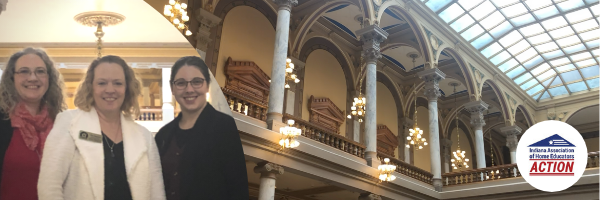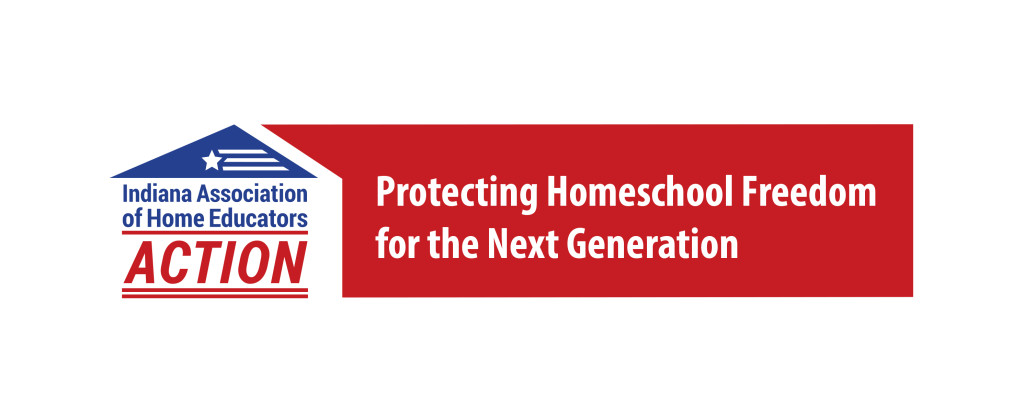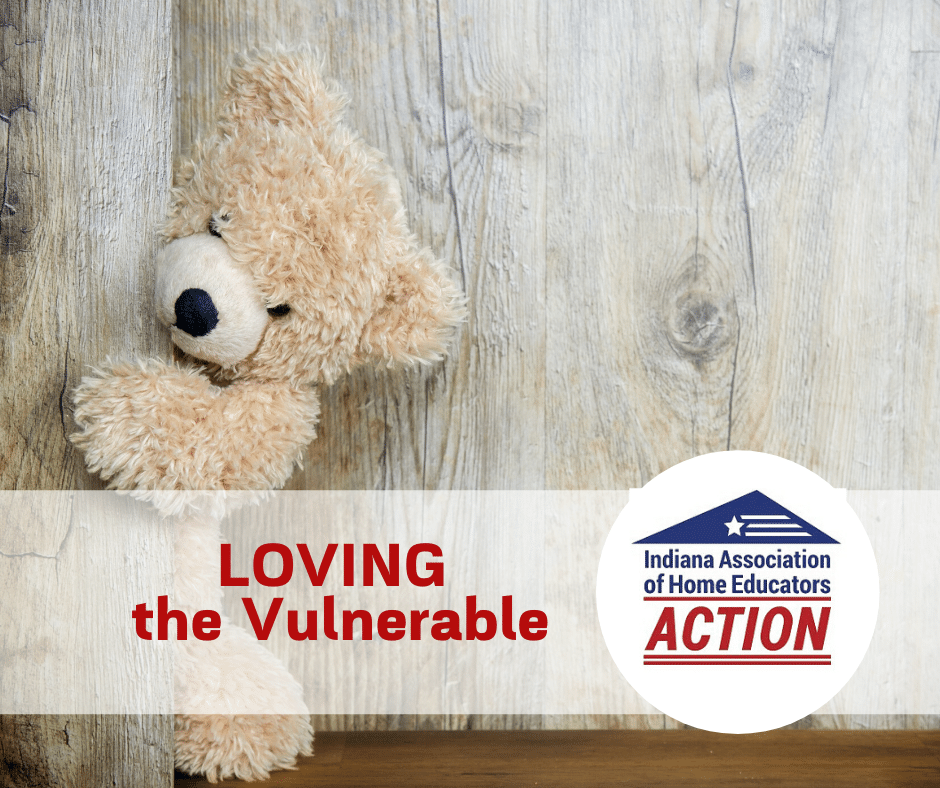Earlier this month, we let you know about SB 428 targeting homeschool families. On Thursday, January 23, 2020, our team visited with state senators and we were assured that this bill was effectively dead thanks to the calls and emails from homeschool families. While we KNOW that until the session is complete there is never a guarantee that any bill is OFFICIALLY dead, we are very grateful that it should not move forward. Thank you for your action!
Special thanks to Senator Greg Walker for being on top of this issue.
Below is our more detailed response to the proposed bill that we shared with them during our visit.
IAHE ACTION

Nothing boils the blood, raises emotion, and brings out the mama and papa bear in most adults like senseless child deaths due to abuse and neglect. Reading the 2018 Annual Report of Child Abuse and Neglect Fatalities in Indiana is a sobering and heart-wrenching catalog of tragedy. The lives of each child listed (regardless of the cause of death) were precious to the God who created them and a loss to the world who no longer has them. A further reality is there are hundreds more children who live in abusive and neglectful situations who will never be listed as fatalities, but their lives are just as precious. Preventing child abuse and neglect should be a priority for everyone.
Prior to our modern era of government agencies taking the lead in child protection, helping vulnerable children was a charitable endeavor. Around the 1800’s, sectarian societies began to establish the “settlement” movement to help provide shelter and basic services for children in need. Even today, many members in the homeschool community are actively involved with Child Protection Services (CPS) by being foster parents. The broader homeschool movement has largely been a mother’s movement to provide a better education and upbringing for their children (adopted or biological) than can be found in current government schools. We love children. And, not just our own children. We love, adopt, protect and are ready to advocate for all children.
Many families choose homeschooling after trying the public schools. Sadly, they found their children were not thriving for a variety of reasons. Perhaps their dyslexic child was denied needed services; or, their offspring became the target of schoolyard bullying. In LaPorte, Indiana, parents discovered their public schooled autistic daughter had been strapped down in a homemade restraint chair that caused bruises and abrasions. Yet another child in Gibson County, Indiana was placed multiple times in a 3 foot by 5 foot seclusion room for up to twenty-six minutes, during which the girl sometimes soiled herself. This happened 106 times during 117 days of public school. For many homeschool families, bringing their child home to educate was in an effort to provide the best possible upbringing and education in the safest environment for their unique learner that was missing in the public school. Fortunately, Indiana law recognizes the parent’s primary role in the instruction of their children.
Parental rights have a long history in Western legal theory going back as far as English Common Law. William Blackstone, a famous English lawyer and professor, had a profound impact on American law through our Founders. They were all familiar with his famous work known as “Commentaries”. Robert Sedler, a law professor at Wayne State University, states that Blackstone set forth the parent-child relationship as the “most universal relation in nature.” Bound within this relationship were three duties parents had to their children: maintenance, protection, and education. Education, in particular, was of greatest importance among the three duties according to Blackstone. Sedler goes on to point out that Blackstone felt contemporary countries were wrong to not require an education for children. We see this sentiment echoed throughout our Federal and State education laws. In the Supreme Court decision allowing the existence of private schools in the United States, Pierce v. Society of Sisters, states, “The child is not the mere creature of the State; those who nurture him and direct his destiny have the right, coupled with the high duty, to recognize and prepare him for additional obligations.”
Further, the Indiana State Constitution states, “Knowledge and learning, generally diffused throughout a community, being essential to the preservation of a free government; it shall be the duty of the General Assembly to encourage by all suitable means, moral, intellectual, scientific, and agricultural improvement.”
This part of the Indiana constitution was further explained in the 1904 case, State v. Peterman which determined the definition of a school in Indiana as “a place where instruction is imparted to the young… We do not think that the number of persons, whether one or many, make a place where instruction is imparted any less or any more a school.” Note, instruction must be taking place. Particularly, instruction equivalent to that given in public schools as later developments showed. If a home cannot be said to be providing an adequate education, it is not a school of any sort.
In the Peterman case, the father was not educating his child at the time. The truancy officer informed him that it was illegal to not provide an education, so Mr. Peterman found a former school teacher near his home who was willing to educate the child. Not providing a child with an education is against the law, no matter where the child happens to be. There is ample case law governing education and the rights of parents to be fundamentally involved in the “maintenance, protection and education” of their children’s lives. Any attempt to single out parents who are educating their children in the home is discriminatory. We have the same rights as parents who make other choices. We must follow the education laws of the State. The Indiana Code even gives schools a mechanism to ensure education is occurring in the home. Indiana Code 20-33-2-20(c) allows the state superintendent and the local school superintendent to request attendance records for non-public schools. Indiana Code 20-33-2-28(b) declares it is unlawful for a parent to fail, neglect or refuse to send a child to public school “unless the child is being provided with instruction equivalent to that given in public schools.” Unfortunately, we know there are unfit parents who do not honor their duties to their children. The Child Abuse and Fatalities Report is evidence of this fact.
Consequently, as we consider the underlying assumption of SB 428 targeting homeschool families, it is clear that Senator Leising believes home-based education carries a greater risk for child fatalities. When IAHE reached out to Sen. Leising’s office, we received the following response: “the senator wants more data on where these deaths are occurring”. The facts do not bear out this type of investigation. In 2018, the Child Abuse and Fatalities Report found that only 6 out of 65 child deaths were school-aged children and none of these cases involved home-based instruction. Of those six deaths, two were murder/suicides. Both cases were of children enrolled in a public school, but were killed by their father who then committed suicide. A third death was a child in the custody of a parent whose family was in the process of having the parent hospitalized for mental illness. Unfortunately for the ten-year-old boy, mental health and protective services moved too slowly to prevent his death. The fourth incident was a 17-year-old who had a history of suicidal thoughts. While tragic, teenage suicide is not unique to any one school setting. The two remaining cases involved drugs. One child found methamphetamine in the possession of her father’s girlfriend and consumed it, which resulted in her death. The other drug-related case involved a parent who was engaged in methamphetamine production. In both cases, the educational setting had nothing to do with their deaths. Instead, the opioid epidemic claimed two innocent victims.
If we look back to the report from 2017, we find a similar pattern. Only three school-age deaths occurred out of twenty-six. One was an accidental drowning of an autistic child who was visiting family, so they did not have all their normal back-up measures to protect him. Another was a child who committed suicide by consuming prescription medication belonging to her legal guardian. The third was due to complications from end-stage renal disease. While the data point to many needs in our community, the numbers do not suggest that home-based instruction is in any way related to child fatalities.
Senator Leising’s bill, SB 428, wants Indiana to identify all children who solely receive home-based instruction. There are a few issues with this philosophically, and even more on a technical level. If investigating the location is the true motivation for this legislation, why is it being targeted at only one demographic? Furthermore, perhaps noting families who have run afoul of truancy laws would also create a full picture. It is well-known that truancy problems are often a warning sign of family instability. Instead, the bill implies that the only families with inherent potential to abuse and neglect children are the ones who home educate. Additionally, 91% of the deaths in 2018 listed in the report are under the compulsory school age, which means this special designation would not apply to the overwhelming majority of the cases. In the 2017 Appendix, 89% of the deaths were of children not yet old enough to be required to attend school. This bill does not address the needs or gain any new information on the demographic most affected by abuse and neglect: families of children under the age of seven. Not only does the bill ignore the needs of the most vulnerable, it encourages sloppy data collection.
The scientific method sets forth basic elements of quantitative data collection. When taking data, a researcher wants to control for variables so the data collected is reliable. The data collection this bill would yield does not account for a myriad of variables inherent in the term: “home based instruction”. There is no regular definition of “home based instruction” in all of the Indiana Code. The enforcement agency would need to fabricate its own working definition to implement the directive of this legislation. This brings to bear a number of other concerns. As an article in Chalkbeat recently reported, schools are mislabeling dropouts as homeschoolers. Will they be added to the “home based instruction” numbers?
Then, there are families who are not providing any education in the home. They do not impart instruction to the young in the home or anywhere else. According the laws of Indiana, they are not schools; yet, will these truants be categorized under this provision? The fatality report includes accidental deaths as well. Not every case listed in the report was as a result of neglect and abuse. Based on the brief description in the 2017 report, the autistic child who drowned was in an attentive home who did their best to protect their child. Unfortunately, despite their best efforts, a parent’s worst fear became their reality. Because the bill does not adequately control for these and other variations, any data gleaned would not meet basic scientific standards, nor could one make any reliable conclusions about the school-age population. However, it would appear to be sufficient to tie child abuse and neglect suspicions upon homeschoolers through media narrative. As Mark Twain once popularized, there are “lies, [darned] lies and statistics.” The data from this bill could be skewed to claim just about anything so long as it sullies one particular demographic.
The problems with this bill are numerous. It ignores the fact that many in the homeschool community work closely with CPS to foster children who originally came to them through the system. It fails to recognize many children have been harmed in the school system, so parents have chosen to protect their children by educating them at home. It implies natural parental rights are suspect and worthy of government supervision while creating an inaccurate data collection mechanism that can be easily distorted to take aim at home educating families. Society throughout the ages has recognized the need to protect children. The homeschool community, many of our member families have been formed through the foster care system, is no different.
Children deserve to be loved as well as maintained, protected and educated. However, remedies to this complex problem need to be based in sound data and focused where it can improve the lives of children, not besmirch the homes of loving parents. Homeschooling provides parents with networks, extracurricular activities, and one-on-one time to bond with children to give them the best start. Homeschooling, at its heart, is about loving the vulnerable.
DONATE NOW to IAHE Action to support ongoing efforts to protect your homeschooling and parental rights.

